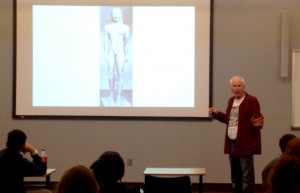by Ben Sheffler

It’s difficult to imagine, but when Dr. Patrick Rowe started teaching Art History in 1983 at Pensacola State College (then Pensacola Junior College), there were no personal computers at the school. There were no copiers in the Visual Arts Department. There wasn’t even a phone in his office.
“I was surprised that I didn’t have my own phone,” Rowe said. “Administrators and faculty soon realized that technology was the wave of the future, and that we needed computers in every office.”
Thirty years later, Dr. Rowe is enjoying the benefits of technology. Although he keeps his lectures traditional, he uses eLearning to post pictures of all the art he covers in the classroom. Sometimes, however, he is forced to bring the dusty slides and projector out from the closet because of pesky technical problems.
“When the computer works it’s a dream, when it doesn’t work it’s a nightmare,” Rowe said.
According to Dr. Rowe, the use of the computer has been the single biggest change to PSC in his time at the college.
“The quality of the digital image is so much better and much more user friendly,” said Dr. Rowe.
Rowe is facing his own big change. In the spring of 2014, he is going to retire to pursue other endeavors.
Rowe has been going non-stop ever since he earned his bachelor’s degree in Art History at Florida Atlantic University. In 1977, while obtaining his master’s degree and Ph.D. from Florida State University in Art History and Classical Archeology, he became a graduate instructor with full teaching responsibilities.
Then in 1983, with no previous connection to Pensacola, Dr. Rowe took a job teaching Art History at PSC.
“There are two paths to take as an art historian, either teach or work in a museum, and I taught in graduate school and was successful. I enjoyed it,” said Dr. Rowe.
Always loving to experience art firsthand, he traveled to Italy every summer from 1976 until 2002 to teach Classical Field Archeology for FSU.
As an art historian, never an artist, Rowe has long had a desire to teach and share artwork. There are six distinct shows of various art collections that Rowe has created throughout the years, and his goal after he retires is to keep these shows traveling and eventually donate them to museums.
“When you earn a Ph.D., you are supposed to do research and add to the body of knowledge in your field. And shows educate the public,” said Dr. Rowe.
From April 12 to June 30, 2013, the Pensacola Museum of Art will feature his collection of works by the 19th century French artist Honoré Daumier. The exhibit consists of 179 original lithographs and wood engravings. Rowe’s entire Daumier collection includes over 600 original prints.
Also at the Pensacola Museum of Art, to honor all active and veteran American soldiers, Rowe’s exhibition of original World War I and World War II posters and flags will be on display. The exhibition will start on Nov. 1, 2013 and run until Jan. 3, 2014, with the opening reception on the Friday before Veterans Day.
Both exhibits are free on Tuesdays and PSC students receive discounted admission.
Students at PSC still have the opportunity to take his Art History classes before he calls it a career next year.
“The class is easy to comprehend and he does not just use the book; he adds his own personal experience,” said Amanda Dobbs, an Art History major at PSC.
Some of his experiences include taking a boat down the Nile River, studying art in Greece, France, England, and his favorite place in the world, Florence, Italy.
“I love the Italian culture, food, art, and attitude towards life. I would live there if I could,” said Rowe.
Rowe’s favorite art and archeology periods he teaches are Aegean Bronze Age, Greek Iron Age, Etruscan, and Roman.
“Dr. Rowe’s personal experience added a huge amount of information and knowledge to the class,” said Scott Fowler, a Photography and Graphic Design major at PSC and former student of Rowe.
Rowe wants his students to grasp as much of the meaning behind the art as possible.
“Understanding art enriches the human experience,” said Rowe
Fowler agrees.
“Understanding the origin of the work and the cultural significance is vital to all art,” Fowler said. “Art reflects the time it was created in, so it holds historical value and not just artistic.”
After enriching the lives of countless students, Rowe is ready to add to his experiences. He understands that the time is coming to move on.
“In the academic world, there are a limited amount of full time teaching positions. So when a teacher retires, hopefully it opens up a full time position for a young person who is fresh out of college,” said Dr. Rowe.
Perhaps someone retired from PSC all those years ago to give Dr. Rowe the same opportunity he hopes to give another.

